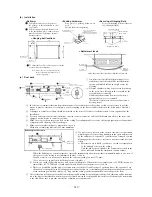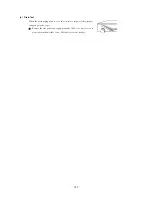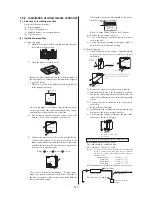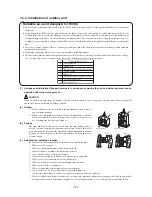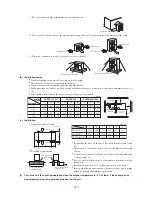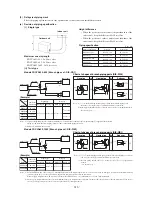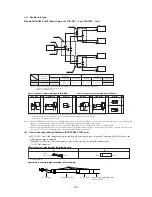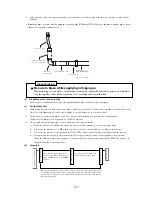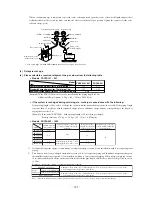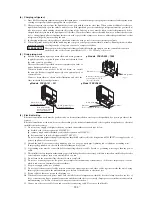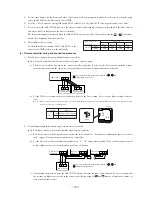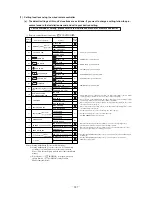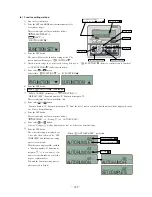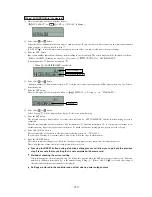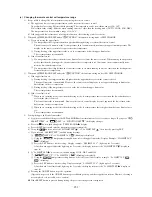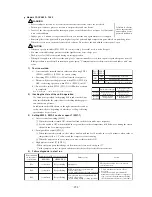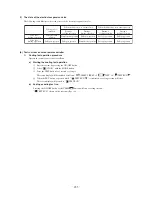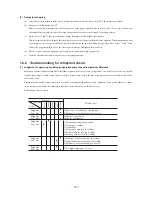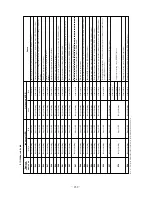
-
224
-
(b) Charging
refrigerant
1) Since R410A refrigerant must be charged in the liquid phase, you should charge it, keeping the container cylinder upside down
or using a refrigerant cylinder equipped with a siphon tube.
2) Charge refrigerant always from the liquid side service port with the service valve shut. When you fi nd it diffi cult to charge a
required amount, fully open the outdoor unit valves on both liquid and gas sides and charge refrigerant from the gas (suction)
side service port, while running the unit in the cooling mode. In doing so, care must be taken so that refrigerant may be dis-
charged from the cylinder in the liquid phase all the time. When the cylinder valve is throttled down or a dedicated conversion
tool to change liquid-phase refrigerant into mist is used to protect the compressor, however, adjust charge conditions so that
refrigerant will gasify upon entering the unit.
3) In charging refrigerant, always charge a calculated volume by using a scale to measure the charge volume.
4) When refrigerant is charged with the unit being run, complete a charge operation within 30 minutes. Running the unit with an
insuffi cient quantity of refrigerant for a long time can cause a compressor failure.
PLEASE NOTE
Please put down the refrigerant volume calculated from the pipe length onto the caution label attached
on the back side of the service panel (Models 151 ~ 251, 302 only: side cover).
(5) Drain piping work
Execute drain piping by using a drain elbow and drain grommets
supplied separately as optional parts, where water drained from
the outdoor unit is a problem.
There are 3 drain holes provided on the bottom plate of an outdoor
unit to discharge condensed water.
When condensed water needs to be led to a drain, etc., install
the unit on a fl at base (supplied separately as an optional part) or
concrete blocks.
Connect a drain elbow as shown in the illustration and close the
other two drain holes with grommets.
Hard vinyl chloride pipe for
general purpose (VP-16)
(local procurement)
Drain grommet
(2 pes.)
Drain elbow (1 pe.)
Models FDCVA402 ~ 1002
Drain elbow (1pc.)
(local procurement)
Drain grommet (4pcs.)
(local procurement)
Head vinyl chloride
general purpose(VP-16)
(local procurement)
Models FDCVA151 ~ 251
Model FDCVA302
Grommet
Drain elbow
Drain hose
(To be arranged on the user's part)
(6) Electrical wiring
Electrical installation work must be performed by an electrical installation service provider qualifi ed by a power provider of the
country.
Electrical installation work must be executed according to the technical standards and other regulations applicable to electrical
installations in the country.
Do not use any supply cord lighter than one specifi ed in parentheses for each type below.
braided cord (code designation 60245 IEC 51),
ordinary tough rubber sheathed cord (code designation 60245 IEC 53)
fl at twin tinsel cord (code designation 60227 IEC 41);
Do not use anything lighter than polychloroprene sheathed fl exible cord (code designation 60245 IEC57) for supply cords of
parts of appliances for outdoor use.
Ground the unit. Do not connect the grounding wire to a gas pipe, water pipe, lightning rod or telephone grounding wire.
If improperly grounded, an electric shock or malfunction may result.
A grounding wire must be connected before connecting the power cable. Provide a grounding wire longer than the power
cable.
The installation of an impulse withstanding type earth leakage breaker is necessary. A failure to install an earth leakage breaker
can result in an accident such as an electric shock or a fi re.
Do not turn on the power until the electrical work is completed.
Do not use a running capacitor for power factor improvement under any circumstances. (It does not improve power factor,
while it can cause an abnormal overheat accident)
For power supply cables, use conduits.
Do not lay electronic control cables (remote control and signaling wires) and other cables together outside the unit. Laying
them together can result in the malfunctioning or a failure of the unit due to electric noises.
Fasten cables so that may not touch the piping etc.
When cables are connected, please make sure that all electrical components within the electrical component box are free of
loose connector coupling or terminal connection and then attach the cover securely. (Improper cover attachment can result in
malfunctioning or a failure of the unit, if water penetrates into the box.)
Always use a three-core cable for an indoor-outdoor connecting cable. Never use a shield cable.

